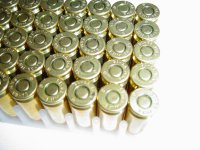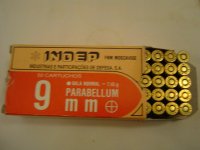Any insight why there is such variation on various 124 grain FMJ NATO round specs? Shouldn't NATO spec be universal and consistant? European stuff is usually higher powered FWIW.
Greek
Brass-cased, non-corrosive, Boxer-primed and FULLY RELOADABLE. 124-grain, loaded with an FMJ bullet. Muzzle Velocity is 1,251 F.P.S.; Muzzle Energy is 431 ft.-lbs.
S&B gov't contract 124 FMJ NATO
UPC SB9B-R
UPC 754908505098
Manufacturer Sellier & Bellot Ammo
Caliber 9mm Luger Ammo
Bullet Type Full Metal Jacket
Muzzle Velocity 1181 fps
Muzzle Energy 384 ft. lbs
Primer Boxer
Casing Brass Casing
Winchester/Olin
SKU: 80864
UPC: 020892212213
MFR#: Q4318
Caliber: 9mm Luger
Bullet Type: Full Metal Jacket
Bullet Weight: 124 Grain
Muzzle Energy: 358 ft lbs
Muzzle Velocity: 1140 fps
These are just 3 for example. Huge swing for the same "spec"
If you look at commercial reloaders who sell "NATO" spec loads, they are even weaker.
When you look at NATO M855 or M193 5.56 round specs from various manufacturers, they all match.
Greek
Brass-cased, non-corrosive, Boxer-primed and FULLY RELOADABLE. 124-grain, loaded with an FMJ bullet. Muzzle Velocity is 1,251 F.P.S.; Muzzle Energy is 431 ft.-lbs.
S&B gov't contract 124 FMJ NATO
UPC SB9B-R
UPC 754908505098
Manufacturer Sellier & Bellot Ammo
Caliber 9mm Luger Ammo
Bullet Type Full Metal Jacket
Muzzle Velocity 1181 fps
Muzzle Energy 384 ft. lbs
Primer Boxer
Casing Brass Casing
Winchester/Olin
SKU: 80864
UPC: 020892212213
MFR#: Q4318
Caliber: 9mm Luger
Bullet Type: Full Metal Jacket
Bullet Weight: 124 Grain
Muzzle Energy: 358 ft lbs
Muzzle Velocity: 1140 fps
These are just 3 for example. Huge swing for the same "spec"
If you look at commercial reloaders who sell "NATO" spec loads, they are even weaker.
When you look at NATO M855 or M193 5.56 round specs from various manufacturers, they all match.
Last edited:


